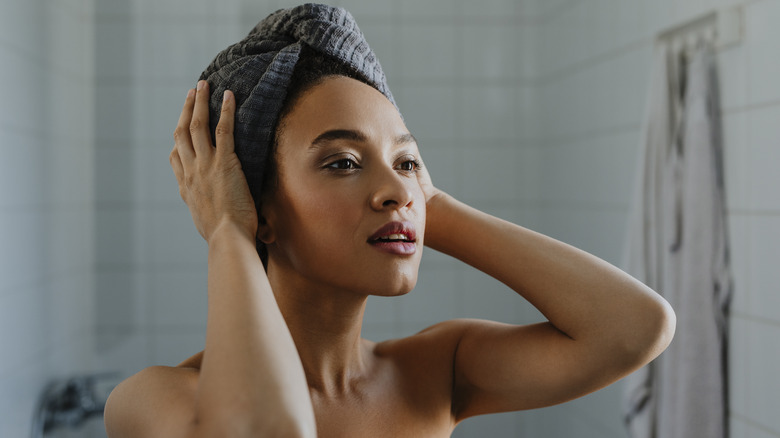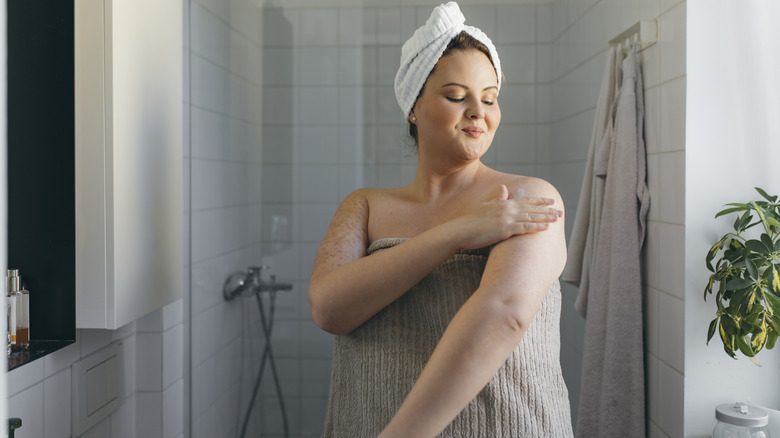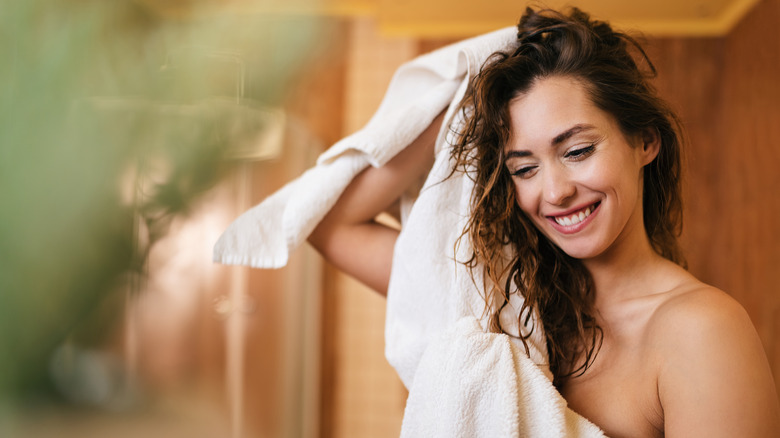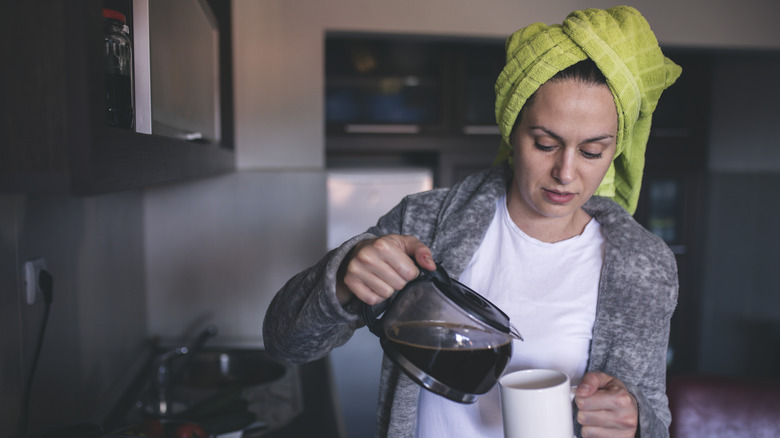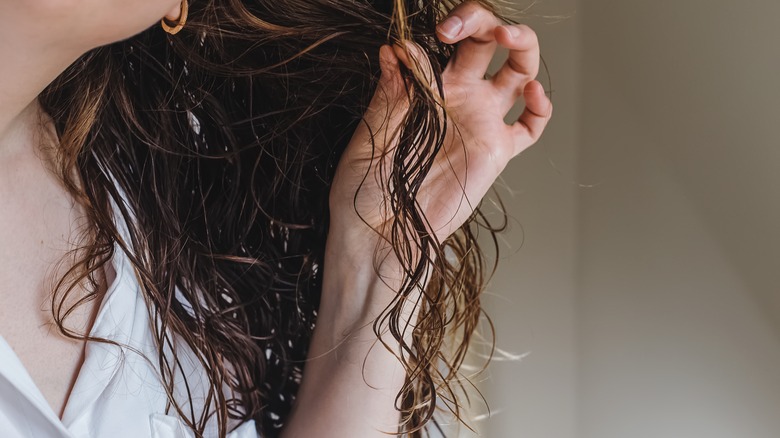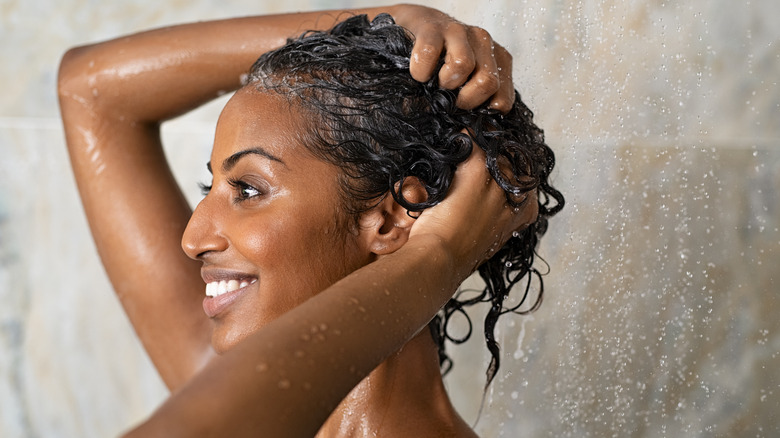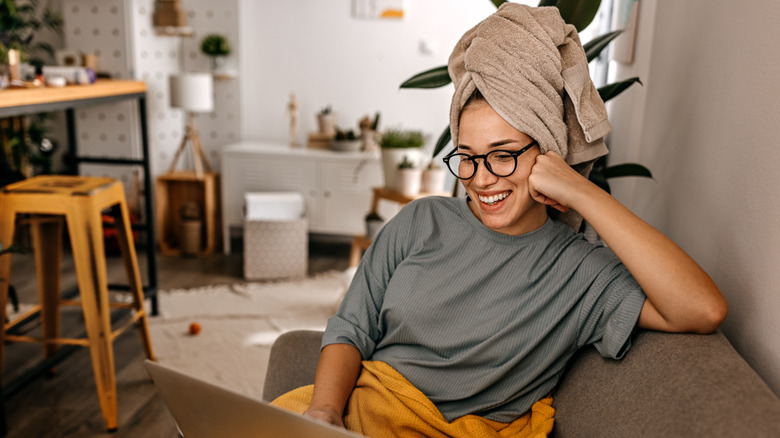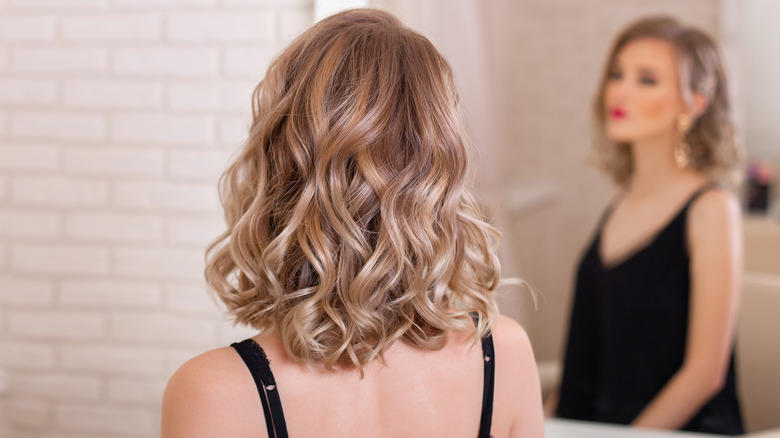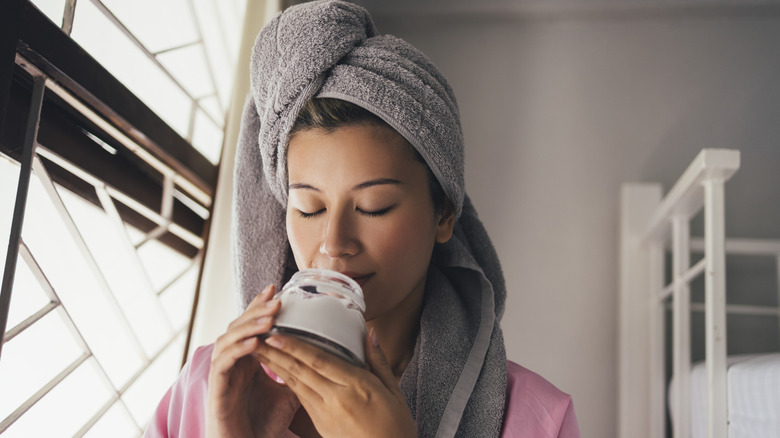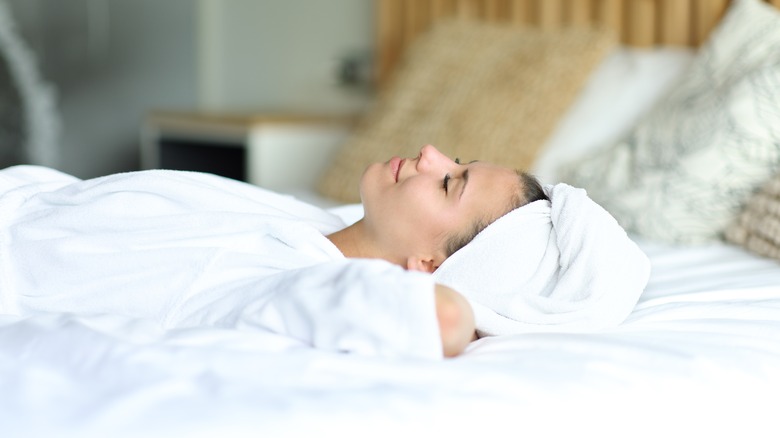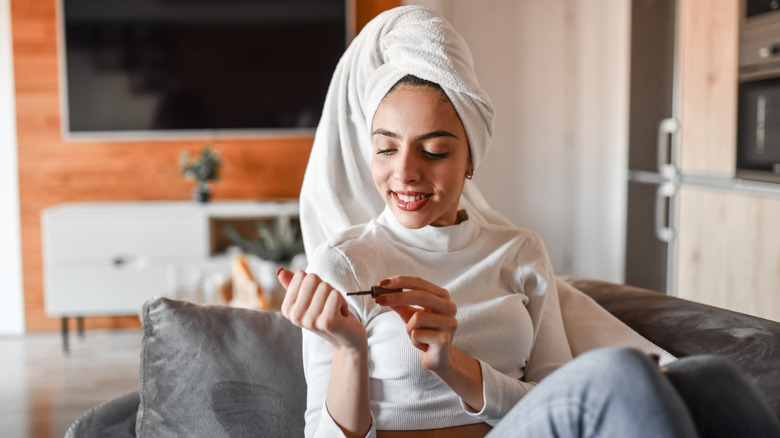Everything You Need To Know About Plopping Your Curly Hair
If you're a curly-haired gal who frequents social media, you've probably heard of hair plopping at least once over the past year or so. It's joined other popular hair care methods (such as the bowl method) as a way to define your post-wash curls, and, as with other methods, it's found plenty of curly girls who swear by it. Why? Not only does it lead to better curl definition, but it can also help lock in some serious moisture, leading to healthier hair overall.
So, why did hair plopping gain such a following, and what's its goal? Anyone with curly hair, especially if it's long, knows the struggle of keeping a good, defined curl pattern post-wash. Blow-drying is often a no-no, and letting it air dry down can lead to a flat, lifeless top since the top of your curls are being weighed down by the length. Hair plopping aims to solve these common curl issues by scrunching your curls on top of your head as they dry, letting your product fully soak in and helping your hair retain some volume up top.
If you've never plopped before and want to try it, you're in the right place. We've got details for all the reasons to plop (as well as some cons), which hair types it works for, and how to plop your hair to get defined curls after every wash.
What is hair plopping?
Hair plopping is a way to dry your curls that reduces frizz and increases curl definition. It involves wrapping your hair in a cotton T-shirt (or a thin cotton towel) on top of your head while it dries. If you already dry your hair by wrapping it in a towel on top of your head, don't be fooled — plopping is a different technique altogether. The traditional towel wrap usually involves entwining your hair with the towel itself, which is only a recipe for curl disaster.
Plopping your hair, on the other hand, wraps your curls together on top of your head, helping them retain definition as they dry. It's recommended that you do this method using either a standard cotton T-shirt or a microfiber towel. Your standard bath towel is pretty thick and tends to cause a good amount of friction against your hair, which can lead to unwelcome frizz. Plus, typical towels absorb too much water.
What hair types does plopping work best on?
Hair plopping is a great post-wash drying option if you have naturally wavy or curly hair. Even the slightest wave pattern can benefit from plopping — it'll just define your wave pattern even more, and you might find your hair is wavier than you thought. This makes plopping a great way to discover if you have texture to your hair that might be hiding behind your typical wash routine.
Even straight hair can be plopped, though. You might not notice a curl pattern magically appear when you plop straight hair, but if your hair tends to be dry or frizz-prone, plopping can help mitigate those issues. If you have low-porosity hair — your hair doesn't absorb moisture and product very easily — you may not benefit much from plopping your hair. However, some trial and error can't hurt, so if you're wondering whether hair plopping will benefit you, go ahead and try it.
How to prep your hair for plopping
Before you run to grab your cotton T-shirt and plop your hair, there are a few prep steps you'll have to do. First, obviously, is washing — plopping won't do too much for dry hair, so you're going to want it to be wet (or at least damp) first. Go through your full wash routine with shampoo and conditioner. Now's a great time to use a deep conditioner if you have one, too, as it'll give your hair some extra moisture to absorb when you plop.
Once you've washed your hair, go ahead and apply any styling products you normally use. You'll want to apply product to wet hair in order to help them soak in while your hair is plopped. This will include your curl cream, leave-in conditioners, hair oils, and any other styling creams you may use. After this, you're ready to plop! Some people recommend slightly drying your hair by squeezing excess moisture out with a cotton or microfiber cloth before you plop, while others suggest plopping your hair fully wet. Everyone's hair is different, so we recommend you try plopping your hair damp one time and wet the next and see what works best for you.
How to plop your hair
Plopping your hair is pretty simple, but if you're just getting started, you may find it helpful to watch a video on how to plop curly hair with a T-shirt. The first thing you'll want to do is find a standard cotton T-shirt (the shirt can have short or long sleeves). Then, put your shirt down on a flat surface like a bed or table, with the top part of the shirt farthest away from you. Flip your head upside down and gently lower your curls onto the middle of the shirt.
Take the bottom part of the shirt and roll it upward until it's tight to your forehead; then bring the top part of the shirt over your curls and down toward the back of your neck. You should have one sleeve near each shoulder or each of your ears. Take the sleeves and tie them together in a knot on top of your head, and voila — you've plopped your hair!
How long should you plop your hair?
Opinions vary when it comes to how long you should plop your hair. Ultimately, this decision is up to you, and it'll require some trial and error to figure out what works for your hair needs (and wants). If your curls are a bit too coiled one day, try plopping for less time next time — conversely, if your curls end up too loose, you could plop for longer. Generally, tight curls shouldn't plop for too long, though.
As far as how often to plop, you should plop after every wash if you want to show your curl pattern off on the daily. Try plopping for 20 minutes at first and see what that does to your hair. If you're left with less volume on top, you may want to plop for longer next time. If you're trying to plop until your hair is completely dry, you may wind up frustrated, especially if you boast a head of thick curls — they probably won't dry completely, as you won't get much airflow through the towel. Try not to plop for much longer than an hour in order to give your curls adequate time to finish air drying.
How do I take my hair out after plopping?
Generally, you shouldn't have to do too much after you plop your hair — after all, you're plopping to help show off your natural hair. You may find that after you take the T-shirt off, you can simply let your hair finish air-drying and it'll look fabulous. If you try this a couple of times and it seems your hair needs a little more TLC, though, there are a few things you can do (and some things you should definitely stop doing).
After you take the T-shirt off of your curls, you want to avoid touching them as much as possible. It's fine to adjust them as you figure out where to part your hair and to get them out of any clumps, but never brush it or run your fingers through it, as that can cause frizz and pull on your curl pattern. If you want, you can scrunch any additional lighter-weight product into your hair, as long as it's still pretty damp. And if you don't have time to wait for your hair to finish air drying, go ahead and diffuse your curls — just be sure to have your blow dryer on the lowest heat setting.
What is net plopping?
Net plopping gives a slight twist to the standard plopping technique by replacing your T-shirt or microfiber towel with a nylon veil net. Follow all the steps you would if you were plopping hair in a T-shirt, but it will feel as if you're plopping your hair into a shower cap. The net should fit snugly around your forehead and the nape of your neck and should be tight enough to compress your curls to your head just as a T-shirt would. A wig cap or tightly-fitting hair net work great for net plopping, but in a pinch, you could always use a pair of fishnet tights.
Net plopping has a few key potential advantages over standard T-shirt plopping. The biggest one is that plopping your hair into a net will allow your curls to dry faster since more of your hair is exposed to the air. Your curls will still be held in tight enough to keep frizz from forming, and you'll be able to see your curl pattern through the net, too, which can help you know when they're ready to be let out of the net. Aside from that, net plopping is a great alternative if you live in hot, sticky summer climates, where wearing a T-shirt on your head could just cause you to sweat all over your freshly-washed hair.
Why plopping is good for your hair
Plopping has many potential benefits for your hair when done right, and only one of them is about your curl aesthetic. Sure, plopping does wonders in helping you show off a head of curls, but it also offers a way to help seriously revitalize dry, dull hair.
When you plop wet hair to dry it, the T-shirt can absorb moisture without rubbing against the shaft of your hair, which is what causes strands to separate and create frizz. Compressing a head of hair full of product tightly against your scalp as it dries also helps seriously lock in moisture which, if you're lucky enough to sport a head of curly hair, you've definitely needed at one point or another. If you suffer from a dry scalp, plopping can help mitigate that as well. Plus, you may find yourself needing fewer additional products in your hair routine down the road. Plopping keeps your curls voluminous without adding any volumizing product (since your hair is drying on top of your head rather than being weighed down as it dries), and it will mitigate your need for frizzy hair products, too.
Does plopping work on short hair?
If you've done any research into hair plopping, you've probably seen plenty of women plopping their long, curly hair into a T-shirt. Plopping seems like it was made for long hair, especially since it's so helpful in keeping heavy locks voluminous. If your curly hair is on the shorter side, you may have found yourself wondering if you can plop, or even if you should.
In short, yes, you can plop your hair even if it's short. There are a few tricks you can employ if you're having a tough time plopping your short hair. First, you may find it easier to plop with a smaller T-shirt, as the fabric on larger or long-sleeved T-shirts can become cumbersome. If you're having trouble gathering your curls together on top of your head, try plopping more against the crown of your head, so the bottom of your curls won't be pulled as far forward. If your hair is on the shorter side, you'll probably also find that you need to plop for less time — try a short, 10-minute plop at first, and if your curls aren't as voluminous as you'd like, try plopping for longer next time.
What are the cons of hair plopping?
At the end of the day, we think plopping is a great practice that all curly-haired humans should try at least once. More often than not, you'll probably find yourself loving your curls even more post-plop. But as with nearly everything, plopping does have potential cons that you should consider before making it a permanent part of your hair routine.
First, plopping will absorb more product than your standard air drying method would, as some product will be soaked up by the T-shirt. You may not notice a difference depending on what products you use in your hair, but you may also find yourself needing to apply slightly more product than you normally would. When you plop regularly, it's also possible that you'll feel you need to wash your hair more. This is because the product is sitting closer to your roots when you plop, which can lead to your scalp feeling greasier sooner than it may otherwise. If you're used to blow-drying your hair, you'll probably also find that plopping takes more time to dry your hair than your usual blow-dry routine, which can be a bit problematic if you're washing right before you head to work in the morning. If you work from home, we recommend plopping in the middle of the day, but if you don't, you could plop right when you get home and still give your hair ample time to dry before bedtime.
Can plopping overnight cause fungus?
Yes, you can plop your curls overnight if you want to minimize maintenance the next morning. In fact, it's a great way to protect your curls while you sleep (along with sleeping on silk pillowcases). But since your hair is unlikely to fully dry while it's plopped, this means you'll be sleeping with a damp scalp all night, and damp environments are a great breeding ground for harmful bacteria.
Basically, yes, it's possible to get a fungal infection if you plop your hair overnight. Some signs of possible fungal infection are scalp itchiness, peeling, flaking, or even hair loss in some extreme cases. If you do plop overnight, we don't recommend doing it often, and if you notice any of these signs of possible infection after plopping overnight, it's a good idea to check in with your dermatologist. However, if you find yourself in a pinch and you can only wash your hair right before bed, don't be too wary of plopping overnight.
What are some common hair plopping mistakes?
All in all, hair plopping is a fairly straightforward practice — just flip, plop, take the T-shirt off, and you're ready to go. If you're plopping and not noticing any difference, however, it could be that you're making a common — and easily overlooked — plopping mistake.
The number one mistake people make when hair plopping is plopping straight into your standard bath towel. Bath towels are great because of how absorbent they are, but this is exactly why you should stay away from them when plopping — they can absorb too much water from the outer part of your hair, causing it to dry unevenly and creating friction that will still leave you with frizz. Plop into a cotton T-shirt or a microfiber towel for best results. You'll also want to make sure the shirt is tied tight enough to your head that it doesn't move around when you do, as any bit of friction is a recipe for frizz galore. Remember to apply product before you plop, not after, to give it adequate time to soak into the shaft of your hair, and be gentle when taking your hair out of the shirt. Only touch your hair sparingly to part it and gently separate curl sections. As long as you're delicate, you should find yourself with a curl pattern you'll love until your next wash.
